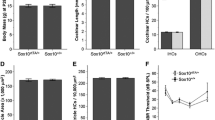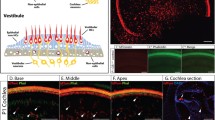Abstract
Calcium-modulating cyclophilin ligand (Caml) is a ubiquitously expressed cytoplasmic protein that is involved in multiple signaling and developmental pathways. An observation in our laboratory of a protein–protein interaction between Caml and the cytoplasmic region of Cadherin23 led us to speculate that Caml might be important in the inner ear and play a role in the development and/or function of hair cells. To address this question, we generated a mouse line in which Caml expression was eliminated in Atoh1-expressing cells of the inner ear upon administration of tamoxifen. Tamoxifen was administered immediately after birth to neonates to assess the effect of loss of Caml in the inner ear during postnatal development. Hearing in treated animals was tested by auditory brain stem response (ABR) analysis and cochlear pathology was evaluated by light microscopy. Lack of Caml expression in the inner ear leads to severe loss of cochlear hair cells and complete deafness. Elucidating the role of Caml in the inner ear will aid our understanding of the molecular pathways important for auditory development and function.





Similar content being viewed by others
References
Adams JC (2009) Immunocytochemical traits of type IV fibrocytes and their possible relations to cochlear function and pathology. J Assoc Res Otolaryngol 10:369–382
Beurg M, Fettiplace R, Nam JH, Ricci AJ (2009) Localization of inner hair cell mechanotransducer channels using high-speed calcium imaging. Nat Neurosci 12:553–558
Bolz H, von Brederlow B, Ramirez A, Bryda EC, Kutsche K, Nothwang HG, Seeliger M, del C-Salcedó Cabrera M, Vila MC, Molina OP, Gal A, Kubisch C (2001) Mutation of CDH23, encoding a new member of the cadherin gene family, causes Usher syndrome type 1D. Nat Genet 27:108–112
Bork JM, Morell RJ, Khan S, Riazuddin S, Wilcox ER, Friedman TB, Griffith AJ (2002) Clinical presentation of DFNB12 and Usher syndrome type 1D. Adv Otorhinolaryngol 61:145–152
Bram RJ, Crabtree GR (1994) Calcium signalling in T cells stimulated by a cyclophilin B-binding protein. Nature 371:355–358
Chow LM, Tian Y, Weber T, Corbett M, Zuo J, Baker SJ (2006) Inducible Cre recombinase activity in mouse cerebellar granule cell precursors and inner ear hair cells. Dev Dyn 235:2991–2998
Denk W, Holt JR, Shepherd GM, Corey DP (1995) Calcium imaging of single stereocilia in hair cells: localization of transduction channels at both ends of tip links. Neuron 15:1311–1321
Di Palma F, Holme RH, Bryda EC, Belyantseva IA, Pellegrino R, Kachar B, Steel KP, Noben-Trauth K (2001) Mutations in Cdh23, encoding a new type of cadherin, cause stereocilia disorganization in waltzer, the mouse model for Usher syndrome type 1D. Nat Genet 27:103–107
Gillespie PG, Muller U (2009) Mechanotransduction by hair cells: models, molecules, and mechanisms. Cell 139:33–44
Guang W, Kim KC, Lillehoj EP (2009) MUC1 mucin interacts with calcium-modulating cyclophilin ligand. Int J Biochem Cell Biol 41:1354–1360
Hayashi S, McMahon AP (2002) Efficient recombination in diverse tissues by a tamoxifen-inducible form of Cre: a tool for temporally regulated gene activation/inactivation in the mouse. Dev Biol 244:305–318
Hequembourg S, Liberman MC (2001) Spiral ligament pathology: a major aspect of age-related cochlear degeneration in C57BL/6 mice. J Assoc Res Otolaryngol 2:118–129
Holloway MP, Bram RJ (1998) Co-localization of calcium-modulating cyclophilin ligand with intracellular calcium pools. J Biol Chem 273:16346–16350
Lim JH, Kim TY, Kim WH, Park JW (2011) CAML promotes prolactin-dependent proliferation of breast cancer cells by facilitating prolactin receptor signaling pathways. Breast Cancer Res Treat 130:19–27
Mammano F (2011) Ca2+ homeostasis defects and hereditary hearing loss. Biofactors 37:182–188
Minowa O, Ikeda K, Sugitani Y, Oshima T, Nakai S, Katori Y, Suzuki M, Furukawa M, Kawase T, Zheng Y, Ogura M, Asada Y, Watanabe K, Yamanaka H, Gotoh S, Nishi-Takeshima M, Sugimoto T, Kikuchi T, Takasaka T, Noda T (1999) Altered cochlear fibrocytes in a mouse model of DFN3 nonsyndromic deafness. Science 285:1408–1411
Nagano J, Kitamura K, Hujer KM, Ward CJ, Bram RJ, Hopfer U, Tomita K, Huang C, Miller RT (2005) Fibrocystin interacts with CAML, a protein involved in Ca(2+) signaling. Biochem Biophys Res Commun 338:880–889
Noben-Trauth K, Zheng QY, Johnson KR (2003) Association of cadherin 23 with polygenic inheritance and genetic modification of sensorineural hearing loss. Nat Genet 35:21–23
Ohlemiller KK (2009) Mechanisms and genes in human strial presbycusis from animal models. Brain Res 1277:70–83
Peng Z, Shi T, Ma D (2010) RNF122: a novel ubiquitin ligase associated with calcium-modulating cyclophilin ligand. BMC Cell Biol 11:41
Pickles JO, Comis SD, Osborne MP (1984) Cross-links between stereocilia in the guinea pig organ of Corti, and their possible relation to sensory transduction. Hear Res 15:103–112
Sher AE (1971) The embryonic and postnatal development of the inner ear of the mouse. Acta Otolaryngol Suppl 285:1–77
Siemens J, Lillo C, Dumont RA, Reynolds A, Williams DS, Gillespie PG, Muller U (2004) Cadherin 23 is a component of the tip link in hair-cell stereocilia. Nature 428:950–955
Sotomayor M, Weihofen WA, Gaudet R, Corey DP (2010) Structural determinants of cadherin-23 function in hearing and deafness. Neuron 66:85–100
Spoendlin H (1984) Factors inducing retrograde degeneration of the cochlear nerve. Ann Otol Rhinol Laryngol Suppl 112:76–82
Tran DD, Russell HR, Sutor SL, van Deursen J, Bram RJ (2003) CAML is required for efficient EGF receptor recycling. Dev Cell 5:245–256
Tran DD, Edgar CE, Heckman KL, Sutor SL, Huntoon CJ, van Deursen J, McKean DL, Bram RJ (2005) CAML is a p56Lck-interacting protein that is required for thymocyte development. Immunity 23:139–152
von Bulow GU, Bram RJ (1997) NF-AT activation induced by a CAML-interacting member of the tumor necrosis factor receptor superfamily. Science 278:138–141
Woods C, Montcouquiol M, Kelley MW (2004) Math1 regulates development of the sensory epithelium in the mammalian cochlea. Nat Neurosci 7:1310–1318
Zhang W, Savelieva KV, Suwanichkul A, Small DL, Kirkpatrick LL, Xu N, Lanthorn TH, Ye GL (2010) Transmembrane and ubiquitin-like domain containing 1 (Tmub1) regulates locomotor activity and wakefulness in mice and interacts with CAMLG. PLoS One 5:e11261
Acknowledgments
This work and EM's participation in the University of Missouri Veterinary Research Scholars Program were supported by University of Missouri Research Animal Diagnostic Laboratory research funds. ABR/EP recordings and cochlear histologic analysis were supported by R01 DC08321 (KKO) and P30 DC0046645 (R. Chole). We thank Dr. Beth Bauer for advice on aspects of the animal work and Howard Wilson for assistance with graphical design.
Author information
Authors and Affiliations
Corresponding author
Rights and permissions
About this article
Cite this article
Bryda, E.C., Johnson, N.T., Ohlemiller, K.K. et al. Conditional deletion of calcium-modulating cyclophilin ligand causes deafness in mice. Mamm Genome 23, 270–276 (2012). https://doi.org/10.1007/s00335-011-9381-z
Received:
Accepted:
Published:
Issue Date:
DOI: https://doi.org/10.1007/s00335-011-9381-z




